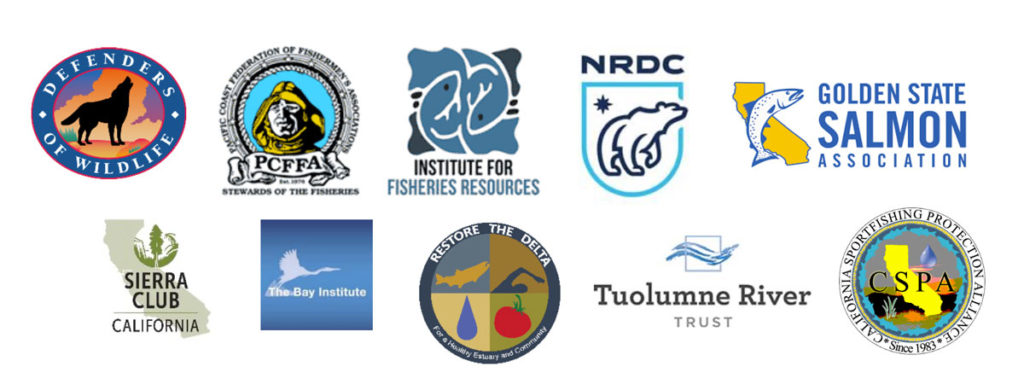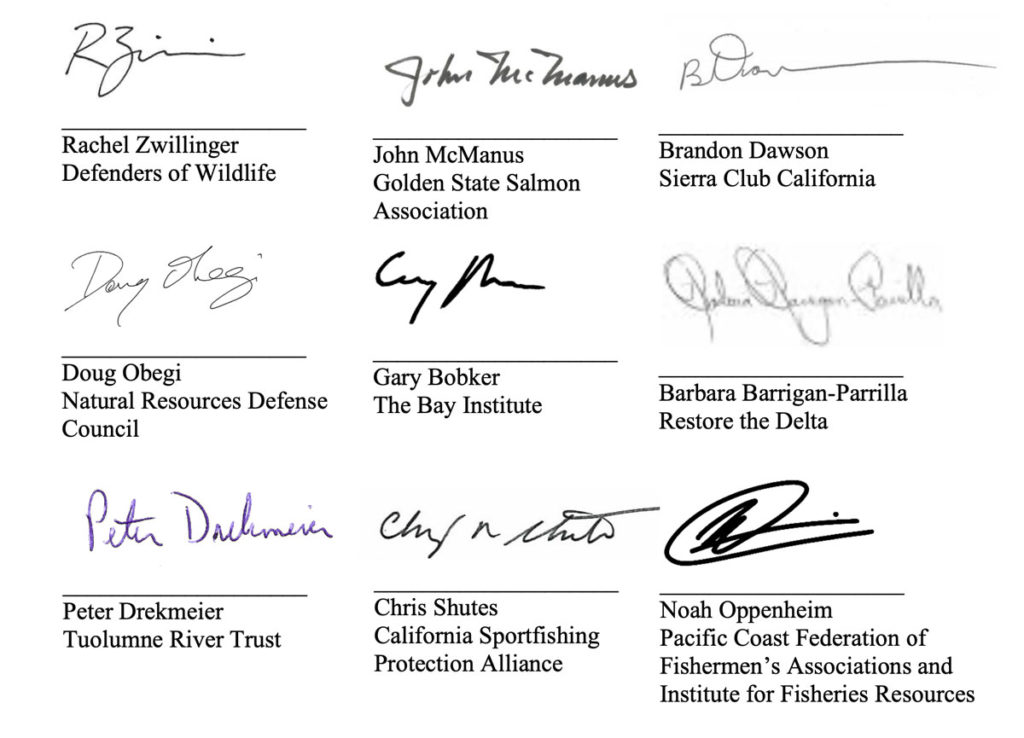Download the PDF here

March 12, 2020
Secretary Wade Crowfoot
California Natural Resources Agency
1416 Ninth Street, Suite 1311
Sacramento, CA 95814
Re: Strengthening California Endangered Species Act protections for threatened and endangered Bay-Delta fish
Dear Secretary Crowfoot,
We are writing to underscore the need for your leadership in ensuring the state adequately strengthens California Endangered Species Act (“CESA”) protections for gravely endangered Bay-Delta species. We greatly appreciate that the State has filed litigation to challenge the Trump Administration’s elimination and weakening of federal Endangered Species Act protections for winter-run and spring-run Chinook salmon, Delta smelt, and other species that are already on the brink of extinction. As the State’s complaint emphasizes, these biological opinions “actually significantly reduce protections for the listed species,” even as state and federal agencies are sounding the alarm that stronger protections are needed to prevent extinction. It is now essential that California strengthens CESA protections compared to existing requirements—which means rejecting the State Water Project operations the California Department of Water Resources (“DWR”) has proposed in its draft environmental impact report and incidental take permit application—to ensure California protects its biodiversity, the Bay- Delta ecosystem, and all of the communities and jobs that depend upon clean waterways and robust salmon runs.
It has long been clear that CESA and ESA protections for native Bay-Delta fish need to be strengthened to safeguard vulnerable species. In 2016, then-Interior Secretary Sally Jewell wrote a memo to the President explaining that the reinitiation of consultation on the 2008 and 2009 biological opinions likely would lead to new or amended biological opinions increasing protections for listed species, and that these new protections would likely reduce water supply from the Delta. State agencies have likewise concluded that California needs to: significantly increase instream flows in the winter and spring months in the Sacramento River and its tributaries, and the San Joaquin River and its tributaries; significantly increase Delta outflows during critical periods; improve temperature management below Shasta and other reservoirs; and maintain scientifically-sound limits on CVP/SWP pumping operations in the Delta.
We support the State’s decision to issue its own CESA permit for the State Water Project, given the obvious inadequacy of the federal biological opinions. However, the State’s independent path is only valuable if the State issues a CESA permit that strengthens protections for listed species. A permit that provides modest improvements from the Trump administration’s biological opinions but that is less protective than existing CESA requirements will fail to safeguard gravely endangered Bay-Delta species. Indeed, a permit that is not more protective than existing CESA requirements will not be sufficient.
As you know, DWR has issued a Draft Environmental Impact Report (“DEIR”) which proposes operations that are nearly identical to the Trump administration’s biological opinions, and which does not consider any alternatives that strengthen protections for endangered species and increases Delta outflow. Both the California Department of Fish and Wildlife (“CDFW”) and the State Water Resources Control Board have raised red flags as to the inadequacy of the DEIR under CEQA and major concerns with the preferred alternative. For instance, the State Water Resources Control Board has commented that:
- “all of the alternatives and the proposed project would potentially reduce protections provided in the 2008 and 2009 BiOps/RPAs, and particularly reduce Delta outflows during the spring”;
- “it is not clear how the proposed project will not further degrade conditions for fish and wildlife species that are already in poor conditions, some of which are on the verge of functional extinction or extirpation”;
- that it appears likely that “fish population decline could continue and increase under the Proposed Project,” but “[g]iven the current historically low abundance levels of listed fish species, it is reasonable that the proposed project strengthen protections for fish species”;
- that “the proposed project would result in considerable impacts to the longfin smelt population,” that the DEIR uses statistical methods that are not credible or scientifically acceptable to asses impacts to longfin smelt, and that the analysis and determination of no significant impact in the DEIR should be revisited; and
- that the DEIR should evaluate a more protective alternative that increases protections, including improved temperature management and increased Delta outflow in the winter and spring.
Although the proposed project in DWR’s application for an incidental take permit (ITP) under CESA is not the same as the proposed project in the DEIR, the ITP application likewise proposes operations that are much less protective than existing CESA requirements and that use the framework of the Trump administration’s operations. In particular, DWR seeks to (1) weaken limits on Delta pumping to allow for Old and Middle River flows at rates known to create river conditions that are detrimental to endangered fish; (2) reduce Delta outflow that is critical for Delta smelt, longfin smelt and other species; (3) avoid setting temperature requirements that are essential for protecting Chinook salmon below Central Valley Project and State Water Project dams in Central Valley rivers, despite the lack of any CESA incidental take authority at these facilities. While the ITP application proposes vague measures to partially reduce the impact of reduced outflow, even with these measures Delta outflow in the winter-spring months would still be lower than today and would harm longfin smelt, salmon, and other species; equally important, those actions are burdened with unreasonable limitations and loopholes, and lack details necessary to ensure that these measures are reasonably certain to occur.
Many of the significant concerns raised in comments by CDFW and State Water Resources Control Board on the DEIR, and in the State’s federal court complaint challenging the federal biological opinions, apply equally to DWR’s proposed operations in its ITP application. For example, the lawsuit highlights that permitted changes in exports and Old and Middle River flows will “indisputably result in more entrainment and other harm to listed salmon,” describes problems related to reduced temperature protections for salmon, and describes how the Bureau of Reclamation failed to analyze the full effects of the proposed Old and Middle River storm provisions.
Similarly, in its comments on the DEIR, CDFW highlighted the inadequacy of DWR’s approach of allowing more negative Old and Middle River flow rates based on real-time monitoring—simply put, the best available science clearly demonstrates that real-time monitoring does not currently provide the information necessary to adequately protect imperiled fish from entrainment and mortality at the south Delta pumps. CDFW’s letter raises many other concerns with DWR’s proposed operations, including highlighting impacts to listed species from more negative Old and Middle River flows and decreased Delta outflow in the spring, impacts to Delta smelt from decreased Delta outflow in September, delayed or uncertain mitigation measures, inadequate salvage triggers, and reliance on experimental measures with uncertain benefits.
In the coming weeks, your agency will make decisions that will determine the fate of endangered Bay-Delta species, including potentially whether Delta smelt, winter-run Chinook salmon, and other species go extinct during Governor Newsom’s time in office. We strongly urge your departments to reject the operations in the DEIR and to reject the operations proposed in the ITP application, and instead require significantly strengthened protections for winter- run Chinook salmon, Delta smelt, and other native fish that are consistent with the best available science.
Among other things, CESA permits that are based on the best available science and consistent with the law should include: (1) prohibitions on Old and Middle River reverse flow
1 DWR used identical modeling assumptions regarding OMR storm waivers in the CALSIM modeling used for the DEIR and ITP application.
rates more negative than -5,000 cfs, as the science clearly indicates that more negative flow rates are detrimental to endangered fish, and adherence to the other reverse flow limitations in the 2008 and 2009 biological opinions; (2) maintenance of a San Joaquin River inflow:export ratio in April and May; (3) increased Delta outflow over and above what has been provided, both directly and indirectly, from the 2008 and 2009 biological opinions; (4) improved temperature protections for salmon spawning downstream of CVP and SWP dams, as compared to those found in the 2008 and 2009 biological opinions; and (5) daily and annual limits on the number of fish that can be killed at the pumps that are truly protective of these gravely endangered species. Mitigation measures must also be based on the best available science (there is little to no evidence that DWR’s current proposal to restore shallow-tidal habitat will mitigate for SWP impacts to any CESA-listed species).
Equally important, for the requirements in the CESA permits to be meaningful, CDFW must either require the State Water Project to ensure that these protective measures are fully implemented—i.e., not merely contributing a proportional share of the minimum necessary to prevent extinction—or, if that is infeasible or impractical, require the Central Valley Project to comply with CESA and share equally in these responsibilities.
Absent such provisions, and given the dire status of these species, we do not see how CDFW could lawfully determine that the incidental take permit would not jeopardize the continued existence of species listed under CESA, nor fully mitigate and minimize the impacts of the coordinated operations of the State Water Project and Central Valley Project. Cal. Fish and Game Code § 2081(c).
Thank you for considering our recommendations. We would be happy to meet with you to discuss any of the matters addressed in this letter.
Sincerely,

cc: Ann O’Leary, Chief of Staff, Office of Governor Gavin Newsom
Jared Blumenfeld, Secretary, California Environmental Protection Agency
Chuck Bonham, Director, California Department of Fish and Wildlife
Karla Nemeth, Director, California Department of Water Resources
Eileen Sobeck, Executive Director, State Water Resources Control Board
